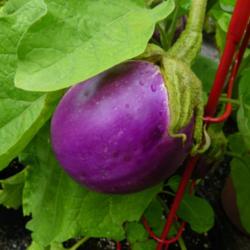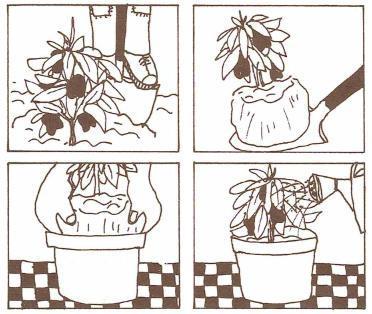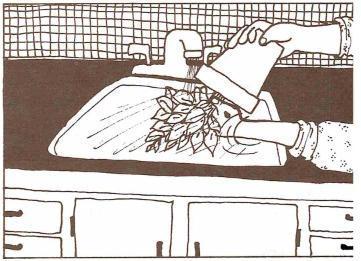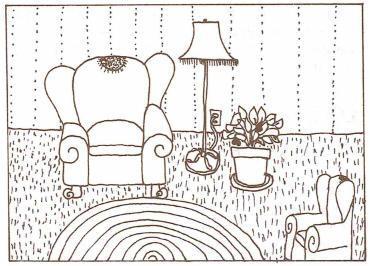
The best way to get the most out of your garden is to extend the harvest. There are a few ways to do this. You can start harvesting as soon as there's something to eat. This tricks the plant into producing more. If your growing season is long enough, you can make successive plantings a week or so apart at the beginning of the season. Because you'll be harvesting at intervals, this method can be a big plus if you don't have the time to do all your canning, freezing or pickling at once.
A fun way to get a longer season from your peppers and eggplant is to bring a couple of plants indoors when the outdoor gardening season is over. This gives you a double bonus for a while; more produce per plant and lush, green houseplants. Before you attempt to bring your plants indoors, however, make sure they're healthy and insect free, and that you have a good indoor location for them. They'll need a sunny window or a grow light.
Up and InTaking your plants from the garden requires the same care you took when you first transplanted them. The best time to do this is on a cloudy day or in the late afternoon. Have all your equipment ready beforehand. You'll need a garden spade, pots and soil.
The pots should be deep enough to provide room for good root growth and their diameter should be 10 to 14 inches (use the 10-inch pots for small plants, the larger pots for big plants). If you use old clay pots, scrub them well to remove all traces of dirt and fertilizer salts (the white, powdery stuff that collects on the inside of clay pots). Clay pots should be soaked in water overnight before you repot to prevent the clay from absorbing the water you give the plants.
Any good brand of store-bought soil or sterilized garden soil can be used as a potting mix.
Presoak PlantsTwo hours before you plan to dig up your plants, give them a good soak. Take your garden spade and dig around the drip line of the leaves of your plant. It's a good idea to dig deeper than you think necessary just to make sure you get the bulk of the roots. Dig straight down, not in towards the stem, to avoid cutting the roots. When you've dug deep enough, lift the plant out of the ground with a spade, supporting the stem with your hand. Gently place the plant in the pot. Fill in the spaces with potting mix, packing it in lightly around the roots. After shaking the pot to settle the soil and eliminate any air pockets, fill in any remaining space up to about an inch below the pot rim with the potting mix. Soak the plant until water comes out the drainage holes. Now your plant is ready to bring indoors.

Indoor care is similar to outdoor care, but this time you have to play mother nature. The eggplant and pepper plants will need a lot of light. They can be temperamental and may not produce if they don't like the conditions, so keep them away from drafts, radiators and heating ducts to avoid extreme temperatures.
Don't water them for a couple of days. This will give broken roots a chance to heal and helps prevent root rot. After the first few days, keep the soil moist but not soaking wet.
Keep an eye out for insect pests, too. In the drier atmosphere of your house, peppers and eggplant are more apt to develop aphids, whiteflies and spider mites. If you see the leaves starting to turn a splotchy yellow, look at the underside of the leaves. Whitish, dusty grains are whitefly or spider mite eggs. If you find them on the bottom of the leaves, it's time to act. If the plants are small enough, tip them upside down under a gentle spray of water and wash away the eggs. A good houseplant insecticide should take care of the insect problems. To keep the insects from spreading, keep the infected plants away from the healthy ones and mist them daily to keep the humidity high.
If you use an insecticide, use it only where you have proper ventilation and away from children and animals. Wait for a week or two after spraying before harvesting, and wash the fruit before you eat it.


Pepper and eggplant flowers need movement for pollination, so you'll have to play the wind indoors. Once blossoms begin to open, gently brush the plants twice daily to stimulate pollination. Indoor eggplant and pepper plants don't have all the benefits of full sunshine, so fruits won't be as large as those grown outdoors (they're usually 1/3 to 1/2 as large as outdoor-grown ones). But since nothing beats eating garden-fresh vegetables in winter, they're worth it.
After you've enjoyed your plants for a few months, they'll start to look peaked. Pick off the fruit and compost the plants. You've gotten your money's worth.
 Victory Seed Company has all the seeds you want for your best garden in 2024.
Victory Seed Company has all the seeds you want for your best garden in 2024.
For 25 years, the family-owned Victory Seed Company has provided the highest quality vegetable, herb and flower seeds to families across the country. We are passionate about providing you the best seeds available that give excellent germination, robust plants, and the harvest you want. With a catalog of over a thousand varieties, we have everything, and our prices are the kinds that we'd want to pay. We have hundreds of yesterday's heirloom vegetables, as well as today's award winning hybrid selections. Get to know us by visiting our website and browsing through our online vegetable seed catalog.
| 1. Fertilizing Eggplant, Peppers, and Okra |
| 2. Watch Out for Weeds in the Pepper Patch |
| 3. Pepper and Eggplant Watering Tips |
| 4. Best Weather for Peppers |
| 5. Adding More Fertilizer to Peppers |
| 6. What's Bugging My Peppers? |
| 7. Insect Control on Peppers |
| 8. Diseases of Eggplant , Pepper, and Okra |
| 9. Stretching the Pepper and Eggplant Season ← you're on this article right now |
| 1. Fertilizing Eggplant, Peppers, and Okra |
| 2. Watch Out for Weeds in the Pepper Patch |
| 3. Pepper and Eggplant Watering Tips |
| 4. Best Weather for Peppers |
| 5. Adding More Fertilizer to Peppers |
| 6. What's Bugging My Peppers? |
| 7. Insect Control on Peppers |
| 8. Diseases of Eggplant , Pepper, and Okra |
| 9. Stretching the Pepper and Eggplant Season ← you're on this article right now |